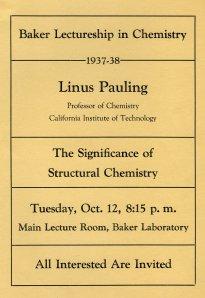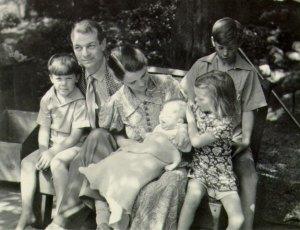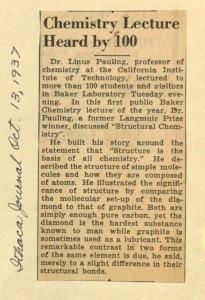
[Celebrating the 75th anniversary of The Nature of the Chemical Bond. Part 2 of 6.]
While Linus Pauling attempted throughout the 1930s to sit down and compose a book-length treatment of his ideas on chemical bonding, he was seemingly destined not to complete it. Burdened, in a sense, by his own and other’s rapid advancements in understanding, early attempts at what would become The Nature of the Chemical Bond quickly went out-of-date if they were even briefly set aside.
A window opened at the end of 1936, when Pauling began to receive offers to serve as visiting fellow at two different institutions on the East Coast. One offer came from the Institute for Advance Study in Princeton, New Jersey, and the other from Cornell University in Ithaca, New York, to give the chemistry department’s George Fischer Baker Lectures. Pauling quickly saw the latter option as a chance to give himself both the time and structure necessary to write his book. The Baker Lectures appeared to Pauling to provide the best circumstances to accomplish this, since every year’s lectures were followed by a publication.
Pauling promptly tried to figure out how his writing of The Nature of the Chemical Bond could fit in with the Baker Lectures. In November 1936, he asked Jacob Papish, who was arranging the fellowship, if an expanded text based on his lectures was possible and how much the book might cost. Pauling wanted the price to be set as low as possible to have a “good sale,” and based his expectations on the one-cent per page cost of previous books published in the series. Royalties were also of interest as Pauling was already planning additional editions and expansions of his yet unwritten book. Papish welcomed Pauling’s idea and suggested (very correctly, as it turned out) that his book would be one of the most successful of the series. However, all royalties for the first edition would go to the Cornell University Press, while royalties for any subsequent editions belonged to Pauling.
With everything seemingly arranged by December, Pauling only needed approval to take leave. The death in June of Caltech chemistry head Arthur A. Noyes created some hesitation in the minds of those around Pauling; as he told Papish, “the authorities of the Institute” questioned whether it was appropriate for him to take leave. The matter was quickly resolved however and Pauling began to plan for his trip the following autumn.

The Pauling family, summer 1937.
Initially Pauling hoped that his whole family, including Ava Helen, Linus Jr., Linda, and Peter, could join him in Ithaca, where they would all stay together in a house. But the family was growing and, in June 1937, Ava Helen gave birth to the youngest Pauling child, Crellin. Linus Pauling, most likely relaying the results of his failed attempts to convince Ava Helen that the whole family make the trip, had told Papish a month before the birth that it would most likely only be him. Ava Helen did end up joining her husband on the train and staying with him for about a month, leaving the children and their dog Tyl in the care of Lola Cook, who lived with the Paulings to assist with childcare and household chores.
Preparations related to Pauling’s work responsibilities were also necessary. Pauling told E. Bright Wilson, Jr. that he planned to stay in Pasadena “until the last possible moment” so he could help the new lab workers settle in and prepare for the coming months without him. Pauling also arranged for a graduate student to work under him while at Cornell, choosing Philip A. Shaffer, Jr. from Harvard rather than someone from Caltech. Shaffer’s assistance was sufficient to merit a mention by Pauling in the preface to The Nature of the Chemical Bond. Two research fellows, however, did accompany Pauling from Caltech: G. C. Hampson, who continued his research on crystal structures, and H. D. Springall, who continued his work on electron diffraction. Both also earned Pauling’s gratitude in the preface.
The Paulings arrived in Ithaca during the last week of September 1937. Their date of arrival gave Linus one week to settle affairs before the start of his duties, which included giving the Baker Lectures on Tuesdays and Thursdays and leading a weekly Wednesday seminar. The couple selected the Telluride House, which housed students, as their residence while in Ithaca, and Pauling wound up staying there for the duration of his lectureship. It didn’t take long for Pauling to make an impact: during the third week of his visit, he gave a public lecture to an audience of 100 that drew the attention of the Cornell Daily Sun and the Ithaca Journal. The town newspaper described Pauling as building “his story around the statement that ‘Structure is the basis of all chemistry,'” a story that was subsequently detailed in the Baker Lectures and The Nature of the Chemical Bond.

At the beginning of November, once living arrangements had been fully ironed out, Ava Helen returned to Pasadena. The separation was difficult for them both. By writing to each other several times a week, they salved their heartache and kept up to date on the everyday activities that occupied them and those around them. Ava Helen kept her husband informed on how Peter was beginning to read, how Linus Jr. was learning to pronounce “competitor,” and how Crellin was being “such a good baby” who “literally never cries.” Though Pauling missed the children, he longed for Ava Helen most of all and told her several times how lonely he was and that working was the only thing that was keeping his emotions together. On November 20, he wrote
I love you, my own dear Ava Helen, with every bit of me. Life doesn’t mean anything while you are away – I live in a sort of daze, with nothing worthwhile. The only thing I can stand to do is to work.
At least in part, it would seem then that it was out of a motivation to suppress his longing to be with his wife and children that Pauling wrote the bulk of The Nature of the Chemical Bond while he was at Cornell.
Pauling’s Cornell correspondence with Ava Helen also chronicles how hard he pushed himself to progress through his writing, to the point where he eventually wore himself out. Handwriting anywhere from ten to forty-plus pages per day of manuscript, Pauling often stayed late at the lab, sometimes until three or four in the morning. This upset his wife, who repeatedly admonished him for working himself too hard. On November 27th she wrote,
You are an awful boy to try to work all night. Your Wednesday (really Thursday) letter came today and I’m mad – hopping mad as Peter says. I told Mrs. Crellin that you worked until 4:10 a.m. (She took us all riding in her electric car this morning for an hour) She said you were shortening your life and that you owed it to your family to take care of yourself. It is wonderful that you were able to get so much done but I do worry about you.
Pauling was indeed able to get a lot done, finishing more than half of the chapters for his first book draft early in December, only a month after Ava Helen had left.
